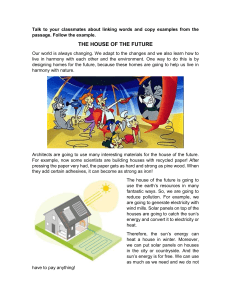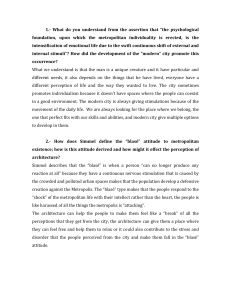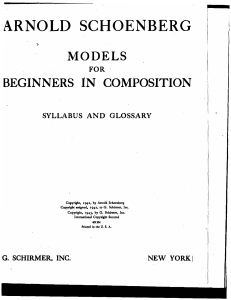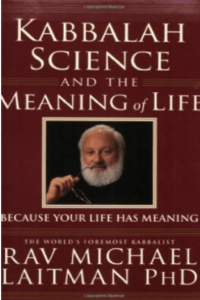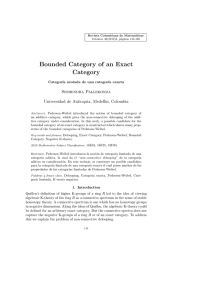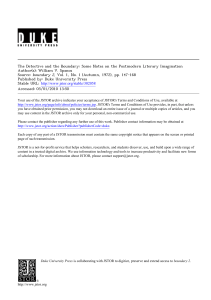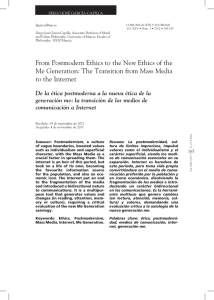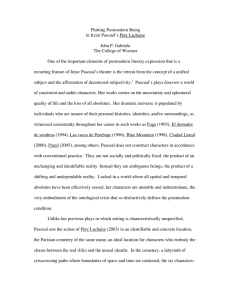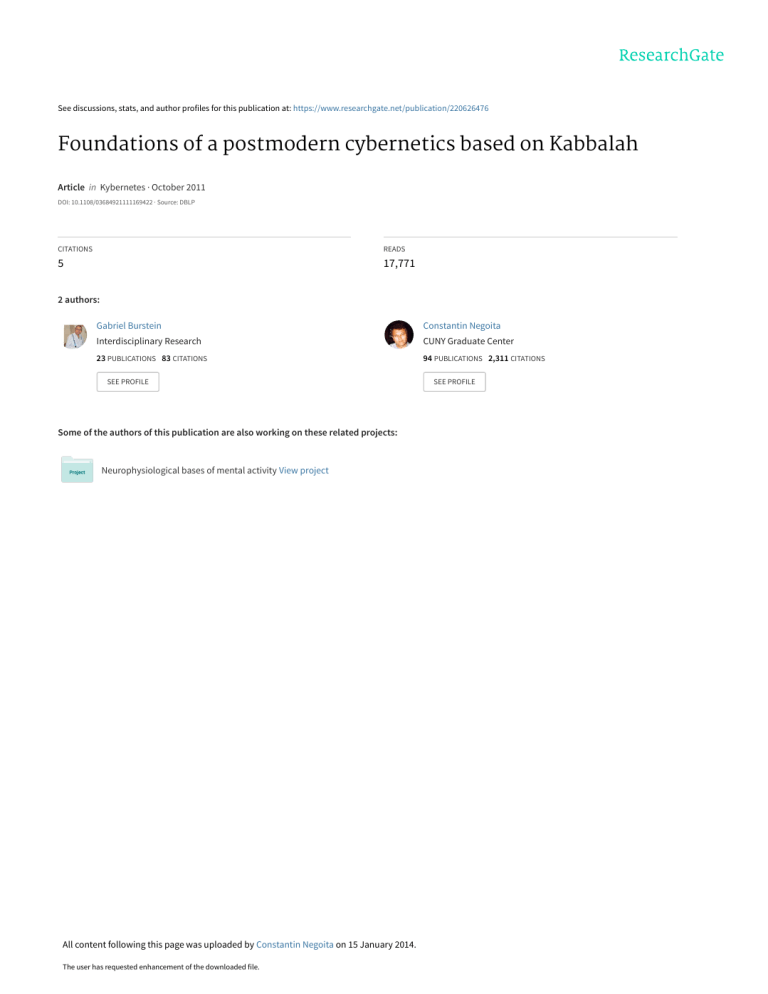
See discussions, stats, and author profiles for this publication at: https://www.researchgate.net/publication/220626476
Foundations of a postmodern cybernetics based on Kabbalah
Article in Kybernetes · October 2011
DOI: 10.1108/03684921111169422 · Source: DBLP
CITATIONS
READS
5
17,771
2 authors:
Gabriel Burstein
Constantin Negoita
Interdisciplinary Research
CUNY Graduate Center
23 PUBLICATIONS 83 CITATIONS
94 PUBLICATIONS 2,311 CITATIONS
SEE PROFILE
Some of the authors of this publication are also working on these related projects:
Neurophysiological bases of mental activity View project
All content following this page was uploaded by Constantin Negoita on 15 January 2014.
The user has requested enhancement of the downloaded file.
SEE PROFILE
The current issue and full text archive of this journal is available at
www.emeraldinsight.com/0368-492X.htm
INVITED PAPER
Foundations of a postmodern
cybernetics based on Kabbalah
Gabriel Burstein and Constantin Virgil Negoita
Cybernetics
based on
Kabbalah
1331
Department of Computer Science, Hunter College,
City University of New York, New York, New York, USA
Abstract
Purpose – This paper seeks to lay the computational and mathematical foundations for a
“postmodern cybernetics” based on ancient Kabbalah. This new Kabbalistic cybernetics is introduced
to act as an unifying science addressing simultaneously, in a common language and framework the
triple nature of human, psychological, social, economic, financial, political, cultural systems and their
present multi-faceted crises and conflicts: cognitive objective level of attaining knowledge; subjective
emotional level and physical action and behavioral level.
Design/methodology/approach – Feedback, hierarchical control and other system and control
theoretic features in the Tree of Life (TL) of Kabbalah were identified. These were used to develop
a general system theoretic framework of a new type to address human and societal system
dynamics, evolution, interaction and feedback control by simultaneously taking into account their
triple nature.
Findings – The postmodern cybernetics of the TL introduced here as a general system framework,
exhibits feedback control with internal model principle, hierarchical control, system multi-valued
logic, category theory pullback and pushout mechanisms, advanced knowledge engineering to
aggregate, learn, evolve and solve problems and crises in an integrated way.
Practical implications – “Kabbalistic postmodern cybernetics” proposed here for human and
societal systems is the unified scientific framework to solve problems that led to or are just related to
economic, financial, political, cultural, societal and human crises and conflicts by addressing their
triple intertwined human nature.
Originality/value – Computational foundations for a postmodern cybernetics based on Kabbalah
are introduced, where the cognitive, emotional and behavioral and physical action facets of
human systems are dealt with in a unified integrated framework to address global problems and
crises.
Keywords Kabbalah, Cybernetics, Feedback, Pullback, Simplicial objects, Multi-valued logic
Paper type Research paper
We shall require a substantially new manner of thinking if mankind is to survive (Albert
Einstein, 1954).
The first author wishes to express all his gratitude for the insightful Kabbalah teachings from:
Naftali Citron, Dovber Pinson, Yitzchak Ginsburg, Reuven Dangur, Nachemyah HaLevi,
Avraham Greenbaum, Avraham Sutton, Michael Laitman, Michoel Seligson, Shlomo Anteby,
Eitan Yardeni, Elie Weinstock, Nathaniel Berman, Eitan Fishbane and Steve Eisenberg. The first
author wishes to dedicate this paper also to the occasion of the 75th birthday of his lifelong dear
mentor Prof. Constantin Virgil Negoita.
Kybernetes
Vol. 40 No. 9/10, 2011
pp. 1331-1353
q Emerald Group Publishing Limited
0368-492X
DOI 10.1108/03684921111169422
K
40,9/10
1332
1. Introduction: Kabbalah and the need for a postmodern cybernetics as
unifying science
Einstein’s quote used as motto for this paper sounds as if it was written for our time.
One of the primary causes of the present economic, financial, political and cultural
crises we are witnessing now is the failure of evolution and growth to address
simultaneously, in a unified way the three basic levels of existence individually and in
society:
(1) objective knowledge, cognitive level;
(2) subjective emotional behavioral level; and
(3) physical action level.
Modern cybernetics is addressing separately and partially only some of those levels,
with different instruments and languages at each level, not within an unitary, unified
cybernetics framework.
The Albert Einstein motto we used for this paper, although stated in 1954, describes
a need which is today even more urgent than it was then. In this postmodern era, the
importance of the spirituality, culture, psychology, sociology and economy facets of the
human existence is seen in the global crises and conflicts produced at almost all of
these levels. This is due to the lack of a unified integrated and scientifically oriented
approach of these aspects from physicality to spirituality. There are many divergent
branches of science for each of these, but there is no one single unifying science, using
the same language and instruments to address all of them as one interconnected
system. Indeed, the old concept of a science of everything may still sound like a joke
but now we know that this is the new integrative manner of thinking to analyze,
prevent or solve the global crises and conflicts we are facing. We do have sciences for
everything but not one general scientific approach of all these aspects taken together in
one common powerful enough scientific language. The postmodern cybernetics based
on Kabbalah that we introduce here, “Kabbalistic cybernetics”, is integrative and
yielding a multi-valued system logic, a need widely felt in postmodernism to avoid the
binary oppositions of classical cybernetic logic (Negoita, 2002; Drob, 2009).
The cybernetics of the 1940s pioneered by Wiener (1948) and many others,
gradually and naturally evolved into very specialized, completely independent areas,
not communicating anymore with each other, addressing different system types with
different languages: general and applied system theory, control theory and
engineering, information science, computing, knowledge engineering and AI. While
this was of great benefit to technological progress and growth and it showed the power
of the initial science of cybernetics, it also had a drawback. Cybernetics ended
fragmented and not able to address in a unified integrative way, with the same
language, the full complex set of all the systems and sub-systems of our existence.
A new, postmodern cybernetics is indeed needed and its computational and
mathematical foundations will be introduced here, based on Kabbalah, to address
simultaneously in a unified language the triple nature of economic, financial, political,
cultural and psychological systems. Such “Kabbalistic postmodern cybernetics” is
aimed to provide the tools to approach modelling and control, manage and to resolve
problems related to the present crises and conflicts in human and societal systems.
Kabbalah is the ancient philosophical analysis of the creation, formation and action
mechanisms of life and human existence and its environment. Though it appeared
before the giving of Torah and Bible, it became the most comprehensive method for
analyzing and Understanding Torah and Judaism. Kabbalah is a scientific method
pioneered and developed across more than two millenniums by Rabbis Shimon Bar
Yochai (Rashbi), Ari (Arizal), Chayyim Vital, Moshe Hayim Luzzatto (Ramhal), Moshe
Cordovero (Ramak), Yehuda Lev Ashlag (Sulam) and many others (Afilalo, 2004;
Laitman, 2005; Luzzato, 2005).
Kabbalah has always been a very logical, analytical positivist approach and a
method of philosophical Judaism but also embraced and researched by Christianity.
It was kept very secret for two millenniums and only revealed and disseminated widely
starting from the late 1990s.
Since its ancient days, Kabbalah proposed the Tree of Life (TL) as an integrated
framework to understand the creation and development of the three basic levels of
human existence. We identify in the TL elements for a general system theoretic
framework of a new type for postmodern cybernetics, exhibiting feedback, hierarchical
control, internal model principle, pullback and pushout mechanisms for aggregation,
learning, evolution and transformation, fuzzy systems and fuzzy logic.
The motivation of the authors is to contribute towards initiating a large program for
our large community of cybernetics (system theorists and engineers, control theorists
and engineers, information theorists, computation theorists and engineers) to benefit
from and indeed to contribute to a new postmodern cybernetics framework addressing
in a unified new scientifical way both the physical and the emotional, psychological
and spiritual levels of human systems and societies. We wrote this only to share how
Kabbalah and cybernetics blended into a Kabbalistic postmodern cybernetics of a new
type, can help the search for solutions to present problems, limitations and crises that
the existing scientific approach cannot address in a unified way and at the full
multi-level of complexity.
2. The TL of Kabbalah as general system theoretic framework for a
postmodern cybernetics
According to Kabbalah, human existence, the physical world and the process of its
creation has ten fundamental general attributes/qualities called sephirot, grouped in
three categories (Menzi and Padeh, 2008):
(1) Knowledge and cognitive level (including objective and spiritual knowledge):
Crown (will, faith, Keter in original Hebrew or Aramaic), Wisdom (Chochmah),
Understanding (Binah) and Knowledge (Daat) which in fact prepares the
transition and implementation of Understanding at the subjective emotional
level. Knowledge itself has a higher and a lower level: the higher level connects
Understanding and Wisdom together while the lower acts as the cognitive
interface with the emotional and physical action levels below. Crown, source of
will, pleasure and Knowledge, normally do not appear together in the TL.
(2) Subjective, emotional level: Lovingkindness (Chesed ), Judgment, Justice,
Strength, Rigor or Severity (Gevurah) and Harmony or Beauty (Tiferet) which
in fact prepares the transition to the next level.
(3) Physical actions level: perseverance or Endurance (Netzach), Victory or Majesty
(Hod ), Foundation (Yesod ) and Kingship (Malchut).
Cybernetics
based on
Kabbalah
1333
K
40,9/10
1334
These ten fundamental attributes of the creation process at spiritual and physical level
are called in Hebrew sefirot (plural, singular: sefira) which means counts, fundamental
units. Despite their metaphorical humanized names, they do represent a coordinate
system of ten general basic attributes that can be used to describe any human, social
and economic systems. In the TL, the ten sephirot fundamental units or components are
represented interconnected by 22 lines based on the interactions between them and
between each of the three fundamental levels described above, in which these sephirot
are integrated (Figure 1).
Think of the ten sefirot as the ten basic states of the general system it describes.
The names of the sephirot should be understood in their whole generality despite the
humanized, anthropomorphic, psychological type of categories used. While, as we will
K
Crown
(Keter)
COGNITIVE
B
Understanding
(Binah)
C
Wisdom
D
KnowLedge
(Chochmah)
(Da’at)
EMOTIONAL
C’
Lovingkindness
G
Judgment
(Gevurah)
(Chesed)
T
Harmony
ACTIONS
(Tiferet)
H
Majesty
N
Endurance
(Hod)
(Netzach)
Y
Foundation
(Yesod)
M
Kingship
(Malchut)
Figure 1.
The TL of Kabbalah with
the ten sefirot plus sefira
Knowledge
Note: A system of interconnected fundamental attributes describing
creation and the cognitive, emotional and action levels of any created
system
show, human personality is one sub-system level described very well in these terms,
sefirot names apply equally to more general systems such as societies, social networks,
economies, activities such as research and development, etc. Lovingkindness, for
example, should not just be understood as the Lovingkindness of one human being
for others but more generally as the act of accepting, adhering to sets of principles or
organizations, providing, giving, etc. Depending on the human system type and level
we will try to model, Judgment will mean not just one person judging others but the act
of assessing, evaluating rigorously, repelling and rejecting theories, legislations,
practices, etc.
These general attributes are so general that they can be applied at various levels of
complexity and aggregation in human systems and they can even describe physical and
biological systems. Even when we name “the subjective emotional level”, think of it in
the spirit of Kabbalah, as representing a metaphorical antropomorphic name of what is
not necessarily just antropomorphic. Such metaphoric language is called the language of
roots and branches in Kabbalah using all sorts of human anatomy parts to stand as
metaphors for much more general abstract attributes and qualities or even processes.
Any human, biological, animal and mineral systems can be described in terms of
the ten sefirot. One of the ancient sources of deriving these sephirot and their order
is generalizing the steps of the creation process in Torah and Bible to describe
sequentially any system from spirituality, consciousness to the physical world. The
order of the sephirot corresponding to the process of creation is given by navigating
across the TL from right to left and back crossing through the middle line and from top
to bottom:
Crown-Wisdom-Understanding-Knowledge-LovingkindnessJudgment-Harmony-Endurance-Foundation-Kingship.
Sephirot in the TL are further organized into configurations of sefirot called partzufim
(plural, singular: partzuf ) which means exactly that, configuration or face. For
example, the complex configuration of five sephirot centered around the sefira of
Harmony (Tiferet) is denoted ZA (Hebrew Zeir Anpin (ZA)) which we prefer to translate
here by small configuration rather than small face. ZA contains Lovingkindness,
Judgment, Endurance, Majesty, Foundation and Harmony itself.
The TL contains three vertical axes: the right axis called the axis of Lovingkindness,
containing the sefira with the same name and the sefirot below and above it on the same
vertical, the left axis called the axis of Judgment, severity or rigor containing the sefira
with the same name and the sephirot below and above it on the same vertical and the
central or middle axis of Mercy containing sefira of Crown and/or sefira Knowledge and
the sephirot below it on the same vertical.
The TL structure is also the best description of the sub-attributes of a particular
sefira taken on its own which means inside each sefira there is a micro-TL or a
sub-TL describing its ten fundamental sub-attributes. The ten sefirot represent the
ten states of a sefira too as a system. This way each sefira possesses information about
the other sefirot with which it is interacting directly or indirectly in the TL (Figure 2).
Sefira Knowledge made up from Lower and Higher Knowledge, contains in the
microstructure of the former five prototypes of sefirot of the right side called chassadim
in Hebrew from Kindnesses for short and five prototypes of the left-side type sefirot
called gevurot from Strengths, Rigors, Judgments. The role of Knowledge is to prepare
Cybernetics
based on
Kabbalah
1335
K
40,9/10
1336
KNOWLEDGE
HIGHER
LOWER
5G 5H
Figure 2.
The TL as a graph where
each of the sefirot nodes is
described by a set of ten
sub-sefirot organized also
according to a sub-TL
structure
Note: Sefira Knowledge is divided into higher and lower Knowledge
the results of Understanding the Wisdom for being applied or implemented in the
emotional and physical action lower levels. We will discuss this in detail in Section 4. The
five Kindnesses and five Strengths are included in the lower level of Knowledge, Daat
Tachton in Hebrew. This lower level implements the knowledge of Understanding
into the practical context of emotions and physical actions or behavior. There is also a
higher level of Knowledge, Daat Elyon, and this one works on connecting Understanding
and Wisdom.
The TL becomes itself the basic building block for higher level structures called
“worlds” describing the four levels of existence, each of these worlds has its own TL
structure made of ten sefirot:
(1) World of Emanation (Atzilut in Hebrew).
(2) World of Creation (Beriah in Hebrew), intellectual, cognitive level created by
enclothing the sephirah Understanding of The World of Emanation.
(3) World of Formation (in Hebrew Yetzirah), emotional level created by enclothing
the sephirah Harmony of the World of Emanation.
(4) World of Action (in Hebrew Asiyah), physical action level created by enclothing
the sephirah Kingship of the World of Emanation.
Cybernetics
based on
Kabbalah
1337
The TL of the four worlds are interconnected in a cascade, from the sefira Kingship of
the world above to the sephirah Crown of the world directly below it, ensuring
structural communication both ways (“Jacob’s Ladder”) but also serving primarily for
one of the sefirah of the World Emanation to enclothe itself and to implement its feature
into one of the successively lower worlds. The three lower worlds have thus roots at
various levels of the World of Emanation (Figure 3).
The hierarchical structure of the four worlds shows how our Kabbalistic framework
for a postmodern cybernetics has many types of interconnecting the basic
microstructural modules, the TL, to build very complex architectures representing
phenomena of increasing complexity at macro levels of existence ranging from
physical, emotional to intellectual and spiritual without needing to truncate the actual
nature of the phenomenon to one of its levels, one gets an “all in one” integrative
modelling capability.
While the origins of formulating the four worlds and their structure are biblical
(Menzi and Padeh, 2008), their sequencing and gradation can describe in particular the
development and implementation of any project starting from idea to physical
implementation.
I
WORLD OF
EMANATION
(Atzilut)
IV
III
II
WORLD OF
WORLD OF
WORLD OF
ACTION
FORMATION
CREATION
(Asiyah):
(Yetzirah):
(Beriah):
rooted in sephirah rooted in sephirah rooted in
sephirah
Harmony
Understanding
Kingship
of World of
of World of
of World of
Emanation
Emanation
Emanation
Figure 3.
The four worlds or
universes of emanation,
creation, formation and
action as a cascade of
corresponding TL
structures with creation,
formation and action
rooted at different levels of
emanation
K
40,9/10
1338
3. Feedback loop control and knowledge engineering in the TL general
system theoretic framework
The TL (Figure 1) allows us to consider it as a new general system theoretic framework
to develop control theory and knowledge engineering simultaneously at
knowledge-cognitive, subjective emotional and physical action levels.
For example, (Figure 4), the sefirotic triad made of Lovingkindness-Judgment-Harmony
(abbreviated as ChaGaT from the initials Chesed-Gevurah-Tiferet of the corresponding
Hebrew words), represents the foundation to study an emotional-level feedback control
loop with Harmony as feedback control helping Lovingkindness to regulate Judgment.
Harmony is known in Kabbalah to represent the sefira of the middle line that helps
maintain the balance between Lovingkindness and Judgment. In specific human and
social system applications, Lovingkindness and Judgment can each be described by a set
of ten state variables for certain approval/rejection, attract/repel arguments, etc. We
already discussed earlier that each sefira has its own ten sefirot elementary states which is
a potential model for the state space sub-vector or sub-structure associated to that
fundamental quality/attribute.
Similarly, the sefirotic triad of Wisdom-Understanding-Knowledge (known as ChaBaD
from the abbreviations of the corresponding Hebrew words Chochmah-Binah-Daat)
is ideal to model a knowledge engineering control system at cognitive level with
Understanding controlling Wisdom using Knowledge feedback at cognitive level
(Figure 5).
Moving to the physical action level, we can model feedback control by using the
sefirotic triad Endurance, Majesty, Foundation, known as NHY based on the initials of
the corresponding Hebrew words Netzach, Hod, Yesod for the three sefirot.
Lovingkindness
Judgment
Harmony
Figure 4.
The TL triad
LovingkindnessJudgment-Harmony
(Chesed-Gevurah-Tiferet
in Hebrew or ChaGaT
denoted C’GT) as a
feedback system
Loving kindness
Judgment
Harmony
Understanding
Wisdom
1339
KNOWLEDGE
Understanding
Cybernetics
based on
Kabbalah
Wisdom
Knowledge
Note: The part of Knowledge most relevant here is higher
Knowledge
Developing complex feedback control system models at the knowledge-cognitive,
emotional and physical action levels, allows us to integrate them hierarchically and
exploit the multi-faceted approach of the TL of Kabbalah to formalize this into a
hierarchical feedback control system with three levels: ChabaD (knowledge-cognitive),
ChaGaT (emotional, subjective response) and NHY (physical action) (Figure 6).
The hierarchical feedback control system ChaBaD ! ChaGaT ! NHY is in fact a
complex of horizontal and vertical, short and long feedback loops, descending and
ascending NHY ! ChaGaT ! ChaBaD, providing the most comprehensive feedback
type for complex human, societal, political, economical, etc. systems since it involves
simultaneously the cognitive, emotional and physical action levels.
4. Internal model feedback control in the TL: sephira Knowledge as
internal model
We can introduce the very advanced robust feedback control concept of “internal model”
in the general system theoretic framework of the TL. Internal model principle of system
theory and control engineering was introduced by Wonham (Wonham, 1976, 1985;
Negoita and Kelemen, 1977) and propelled feedback control engineering to the new level
of robust feedback control for any external perturbations coming from the exosystem
(environment) of the controlled system. Internal model principle states briefly that a
robust feedback controller (not affected by perturbations) of the controlled system must
incorporate a duplicated internal model of the disturbances to which the controlled
system is subjected from the external environment, the exosystem.
Take for example the case of Understanding and Knowledge control of Harmony.
In Kabbalah, Understanding and Lower Knowledge particularly influence and control
Figure 5.
The TL triad
Wisdom-UnderstandingKnowledge
(Chochmah-Binah-Daat in
Hebrew or ChaBaD
denoted CBD) as a
feedback system
K
40,9/10
Understanding
(ChaBaD or CBD)
Cognitive level
Wisdom
Knowledge
1340
Judgment
(ChaGaT or C’GT)
Subjective emotional
Lovingkindness
Harmony
(NHY)
Majesty
Action level
Figure 6.
The TL as a hierarchic
feedback control system
with levels cognitive,
emotional, action
described by the triads
Endurance
Foundation
Notes: Wisdom-Understanding-Knowledge (CBD); LovingkindnessJudgment-Harmony (CGT); Endurance-Majesty-Foundation (NHY)
the formation and “rectification” (Tikkun in Hebrew) of the configuration of Harmony
called the partzuf of ZA (in Hebrew, long face or long configuration) (Afilalo, 2004;
Luzzato, 2005).
The surrounding environment of Harmony in ZA is made of five sefirot
(Lovingkindness-Judgment-Endurance-Majesty-Foundation). We call this the
configuration of Harmony and include the sefira of Harmony itself in it as the sixth.
The sub-TL inside each of these five sephirot has a right side of Lovingkindness and a
left side of Judgment. The sefirot from the left side are of the type gevurot (prototype
component of Judgment in the TL). The sefirot from the right side are of the type
chassadim (prototype component of Lovingkindness). Hence, there are altogether
five Lovingkindness sides and five Judgment sides in the exosystem of Harmony.
An internal model of the exosystem of Harmony should contain at least
five chassadim and five gevurot to model the environment of Harmony subjected to
five interactions of the right side and five interactions of the left side coming from
the five sephirot of ZA. Lower Knowledge has five chassadim and five gevurot as
Kabbalah teaches, that is five elementary prototype components of the right
lovingkindness side and five prototypes of the left judgment side. To be precise,
sephirah Knowledge has Upper Knowledge and Lower Knowledge. Lower Knowledge
has an internal model of the configuration of Harmony as its main function is to be the
interface of cognitive level with the emotional and physical action level hence it
subjectivizes knowledge to be implemented in emotions and actions/behavior. The
upper component of Knowledge is the one serving to regulate the relationship
Understanding-Wisdom as we show in Figure 5. In Hebrew, the latter is Da’at Elyon
while the former is Da’at Tachton (Figure 7).
Hence, in the feedback loop in which Understanding and Wisdom control Harmony,
Lower Knowledge plays the role of the internal model of the external environment of
Harmony used by the Understanding-Wisdom controller to “steer” Harmony and its
configuration (Figure 8).
Cybernetics
based on
Kabbalah
1341
5. Mathematical and computational framework for the Kabbalistic
postmodern cybernetics: category and topos theory, pushout and pullback
We are introducing here some of the most natural mathematical instruments to capture
the complex multi-faceted mechanisms in the TL as a general system theoretic
framework for Kabbalistic cybernetics.
The TL and its microstructure taking into the account the sub-TL of each of its
sefirot, can be represented mathematically as a graph fibration (Boldi and Vigna, 2002).
A fibration has a “base space” and a standard “fibre space” over of the “points” of the
base space. In our case, the fibre is the sub-TL of each sefirah in the TL acting as fibre
over each sefira of the TL base space with the natural projection (Figure 9):
P : TL £ TL ! TL
Lower knowledge
(5 Kindnesses or Chassadim
And 5 Strengths or Gevurot (5C,5G))
Lovingkindness
Judgment
Harmony
Majesty
Endurance
Foundation
Figure 7.
The configuration of
sefirot of Harmony
( partzuf ZA in Hebrew)
and its internal model,
lower Knowledge, which
contains five prototypes of
strength/judgment
sephirot type and five
prototypes of kindness
sephirot type in
equilibrium
K
40,9/10
1342
Internal Model of Exosystem
Lower
Knowledge
Understanding
Wisdom
Higher Knowledge
Harmony
Controlled System
Figure 8.
The internal model
feedback control system of
the sefirot of Harmony
using lower Knowledge as
an internal model for the
exosystem of Harmony
Configuration
of Harmony
(“partzuf ZA”)
Exosystem
Notes: This is the configuration of sefirot of Harmony (ZA in Hebrew);
remark the higher Knowledge small feedback loop of the “controller”
Understanding-Wisdom
Tree of Life as a graph fibration (graph product)
(TLxTL)
=
Projection map (P)
P: TLxTL → TL
Figure 9.
The TL with its sefirot and
their sub-sefirot as a graph
fibration (graph product)
Tree of Life Fibre
of each sefira
(TL)
Tree of Life Base Space (graph)
(TL)
The fibration is trivial and is in fact a Cartesian product of graphs as the TL defines a
graph (directed graph) with vertices given by sefirot and edges given by the
connectivities between sefirot. For simplicity, in what follows, we will not draw the
direction/orientation of arcs. The Cartesian product of graphs (Imrich and Klavzar, 2000)
TL £ TL between the graph of the TL and itself, seen as a model for the sub-TL of each
sefira, gives us an equivalent representation of the TL and its microstructure. We have
here a graph base and a graph fibre in a graph fibration.
The TL with its sefirot and directed edges or arcs connecting the sefirot defines
possible state transitions between one sefirot to another along the arcs of the TL graph
and the graph pathways, cycles, etc. generated by combining them according to the
orientation. This can be modeled as a finite state automata or dynamic system with a
state space or state set denoted TL from TL being a set of the ten sefirot and a
dynamics map of transitions between the states of sephirot according to the graph of
the tree:
D : TL ! TL
This dynamic system in the base space can be “lifted up” to a dynamic system on the
graph fibration itself LF £ LF. As we will see in Section 6, the logic of this dynamic
system in the category of dynamic systems (Lawvere and Schanuel, 2005) is
multi-valued, with a countable infinity of truth values and it offers a great structural
algebraic logic framework to avoid binary oppositions from classic cybernetics to
satisfy the requirements of postmodern cybernetics (Negoita, 2002; Drob, 2009).
The TL, seen as a graph with sefirot as nodes and their 22 interconnections as arcs
belongs to the category of graphs from category theory (Lawvere and Schanuel, 2005;
Boldi and Vigna, 2002; Vigna, 1997). A category of graphs is made of graphs as objects
and morphisms between graphs including the possible compositions of such
morphisms. In fact graphs form a special type of category of graphs called “topos” or a
presheaf category which has many useful properties for modelling.
The TL as a graph can also be seen as generating its own free category, a diagram
generated category C (TL) having as objects the sefirot seen each, in its turn, as a graph
or set of ten states given by each sefira’s sub-TL (Figure 2).
The morphisms between sefirot, indicated by the edges of the TL, are defined as
mappings between the corresponding graphs or sets of ten states given by the sub-TL
of each sefira. In addition, we add identity morphisms for each sefira, mapping each
sefira set of sub-sefirot into itself, seen as self-loops or identity arcs. The composition
rule for these morphisms is simply following the multiple possible pathways in the TL
seen as a directed graph with orientation.
An immediate interesting property of C (TL) is that sefira Crown (Keter) is initial
object in that category, denoted by 0, meaning that for any object in the category, there
is a path and correspondingly a composed morphism from Crown to that object.
Similarly, Kingship (Malchut) is a terminal object, denoted 1, meaning that from any
sefira there is a path from that sefira into Kingship. We say that C (TL) is a category
with initial and terminal objects.
In what follows, we will concentrate on the TL in the framework of the category of
graphs rather than the freely generated diagram category.
Let us model the process by which the configuration of Harmony cognitive
sub-system is created as a “pullback”, to be defined below, of Wisdom and
Understanding over Knowledge. The knowledge engineering system ChaBaD
(CBD) introduced earlier (Wisdom-Understanding-Knowledge) plays a crucial role
in stabilizing the subjective emotional level represented by the configuration
of Harmony known as ZA (small configuration in Hebrew) given by
Cybernetics
based on
Kabbalah
1343
K
40,9/10
1344
Lovingkindness-Judgment-Endurance-Majesty-Foundation and Harmony itself. This
stabilizing effect is done through providing ZA with its own cognitive sub-system (brain
or mochin in Hebrew) adapted for the subjective emotional processes in preparation for
actions.
Let us briefly introduce the pushout and pullback operations from category theory
in order to model algebraic mechanisms in the category of graphs.
Definition 1. The pushout of objects A and B over object C in the category of
graphs, where A, B, C are connected by the morphisms g: C ! B, f: C ! A, is an object
PO together with morphisms n: B ! PO and m: A ! PO such that:
.
The diagram in Figure 10 commutes that is mof ¼ nog where “o” denotes
morphism composition.
.
PO has the universality property meaning that for any other object, P, in the
category and morphisms m0 : A ! P and n0 : B ! P that satisfy the
commutativity of the diagram in Figure 10, that is m0 o f ¼ n0 o g, there exists
a unique morphism p: PO ! P such that p o m ¼ m0 and p o n ¼ n0 (Figure 10).
We introduce next a concept dual to pushout in category theory, pullback, obtained by
reversing the morphisms and hence the arrows in Definition 1.
Definition 2. The pullback of objects A and B over object C in the category of
graphs, where A, B, C are connected by the morphisms g: B ! C, f: A ! C, is an object
PB together with morphisms n: PB ! B and m: PB ! A such that:
P
n’
P
m’
PO
Figure 10.
The category theoretic
commuting diagram
definition of the pullback
PB of A and B over C
including the universality
property of PB with
respect to any other P
n
m
A
B
g
f
C
.
.
The diagram in Figure 11 commutes that is fom ¼ gon where “o” denotes
morphism composition.
PB has the universality property meaning that for any other object, P, in the
category and morphisms m0 : P ! A and n0 : P ! B that satisfy the commutativity
of the diagram in Figure 11 that is m0 o f ¼ n0 o g, there exists a unique morphism
p: PO ! P such that m o p ¼ m0 and n o p ¼ n0 (Figure 11).
Cybernetics
based on
Kabbalah
1345
In the early 1980s, Negoita (1985), following the applied category theory school of
Goguen, was among the first to introduce pullback in cybernetics for modelling
complex systems, expert systems and human system management. While feedback
ensures bi-directional connectivity of flows in systems, pullback allows aggregation of
criteria and information in cybernetics. Just like feedback was quintessential for
cybernetics, we will show here how pullback and pushout become the center
mechanisms for the Kabbalistic postmodern cybernetics we are formalizing here.
The construction of the cognitive sub-system CBD, “brain” or mochin in Hebrew,
involves the pullback of Understanding and Wisdom (Binah and Chochmah in Hebrew)
over Knowledge (Daat) as a mechanism to transfer knowledge from a higher cognitive
level to a lower emotional, behavioral and physical action level, the sub-system, ZA
(Figure 12).
For complex, multi-faceted human system cybernetics in the TL general system
theoretic framework proposed here, pushout allows to model the hierarchical
P
n’
P
m’
PB
n
m
A
B
g
f
C
Figure 11.
The category theoretic
commuting diagram
definition of the pushout
PO of A and B over C
including the universality
property of PO with
respect to any other P
K
40,9/10
Harmony
Cognitive
CBD
Wisdom
1346
Figure 12.
The cognitive sub-system
of the configuration of
Harmony (ZA in Hebrew)
as a pullback of Wisdom
and Understanding over
Knowledge corresponding
to the forward
propagation across the
tree (“direct light”)
Understanding
Knowledge
actualization of higher cognitive levels based on the emotional and action experience of
the lower levels by updating aggregation and synthesis.
What pushout does, for example, is to “glue together” sefirot Kingship and Harmony
along sefira Foundation which has reflected in it both the five Kindnesses of Harmony
and the five Strengths of Kingship (Afilalo, 2004; Luzzato, 2005) in order to request an
actualized version of Lower Knowledge from Understanding which requests that from
Wisdom (Figure 13).
In Kabbalah, this is the central mechanism of periodic “reparation” and re-actualization
called in Hebrew Tikkun (repair). Pushout becomes thus a mathematical solution in the
correction or Tikkun of complex human, societal, economic, etc. systems and their crises.
It is known as the process of “raising Kingship (Malchut) to Understanding (Binah)” and
Lower
Knowledge
Figure 13.
Lower Knowledge as
pushout of Harmony and
Kingship over Foundation
corresponding to the
“returning light”
propagation across the TL
Kingship
Harmony
Foundation
“uniting Harmony (Tiferet or ZA) with Kingship (Nukva or Malchut) in order to ascend to
Understanding (Binah)” and to receive the re-actualized (Lower) Knowledge mochin or
brain (Laitman, 2005).
The TL has both downwards and upwards, direct and returning flows of
information and processes (“light”): we talk in the Kabbalah of Creation of Ari about
“light of Creation” propagating down as Direct Light and returning back upwards as
Returning Light (Afilalo, 2004). We have katnut maturation process (smallness) going
up and gadlut (greatness) coming back down (Laitman, 2005), modeled here through
inter-sefirotic feedback loops. Pullback can model the direct, going down construction
processes, and pushout, the returning back up periodic re-actualization across the TL.
The category theoretic duality of pullback – pushout is an ideal model for the
katnut-gadlut pair of essential processes in Kabbalah described above. The necessity of
both pushout and pullback for cognitive processes such as concept learning has been
already proven (Neuman and Nave, 2008).
The category of graphs has a very rich structure known as “topos” (Lawvere and
Schanuel, 2005; MacLane and Moerdijk, 1992; Vigna, 1997). One of the essential
properties is that in the topos of graphs, we can always compute the pullback of two
graphs. The result will be a sub-graph of the tensor product (also known as direct
product or Kronecker product of graphs) (Bauderon, 1995). The node set of the tensor
product is the Cartesian product of the node sets of the two graphs and an arc connects
two pairs of nodes in the tensor product provided the first components of the two pairs
are connected in the first graph and the second components of the two pairs are
connected in the second graph of the product (Imrich and Klavzar, 2000).
Our algebraic topos theoretic computational foundation is based on analysing the
TL and its sub-graphs in the context of the topos of graphs powerful tools. For
example, we can expand the full computational foundations involved in implementing
the pullback in Figure 12 (Figure 14).
Based on the wisdom unveiled in the Kabbalah of Ari (Luzzato, 2005; Afilalo, 2004),
the process of transfer of Lower Knowledge from sefira Daat (D) into the cognitive level
of the lower configuration of Harmony (ZA) is done by the Action sub-systems, NHY of
Understanding and NHY of wisdom. These are transferring the five Kindnesses and
five Strengths from Lower Knowledge.
Computationally, what is happening in Figure 12 as expanded in Figure 14, is the
creation of the cognitive sub-system CBD of the configuration of Harmony by pullback
of NHY of Understanding with NHY of Wisdom over Lower Knowledge. CBD of ZA,
the configuration of Harmony, is the sub-graph of the tensor product of NHY Wisdom
with NHY Understanding such that this sub-graph is mapped node by node and arc by
arc into the same sub-graph of Lower Knowledge by both sides of the commuting
pullback diagram shown in Figure 14.
6. A multi-valued dynamic system logic for Kabbalah and the Kabbalistic
postmodern cybernetics
One of the essential themes of postmodernism is the renewed need to accommodate a
pluralistic, multi-valued logic to escape the number one source of conflicts and crises
due to the 0-1, black and white, yes or no classical logic (Drob, 2009; Negoita, 2002).
The TL of Kabbalah represents even from this point of view an ideal solution.
The tree has three axes: right corresponding to acceptance and Lovingkindness,
Cybernetics
based on
Kabbalah
1347
K
40,9/10
THE COGNITIVE SYSTEM (CBD) OF
THE HARMONY CONFIGURATION
N1Y2
ACTION TRIAD NHY OF
WISDOM
(CHOCHMAH)
H1Y2
N2
H2
P2
1348
Y1Y2
N1H2
D
Y2
H1H2
B
PULLBACK
C
Y1H2
H1N2
N1N2
Y1N2
Figure 14.
Pullback diagram in the
topos of graphs for the
construction of the
cognitive sub-system of
the configuration of
Harmony (ZA) as a
pullback of the NHY
action sub-system of
Understanding and NHY
action sub-system of
Wisdom over the lower
Knowledge (Daat Tachton
in Hebrew)
(N1H1Y1) × (N2H2Y2)
P1
LOWER KNOWLEDGE
(DAAT TACHTON)
N1
H1
H
N
Y1
ACTION TRIAD NHY OF
UNDERSTANDING
(BINAH)
Y
left corresponding to judgment and rejection and the middle line of reconciling the two
different left and right lines (mercy line or rachamin in Hebrew).
The seed of the expansion of the reconciliatory middle line emanates from the model
of sefira Knowledge which gathers together in equilibrium both the five prototypes of
left Judgments and Strengths and the five prototypes of right Kindnesses.
Regarding the TL as a graph in the topos of graphs, allows us to exploit the
powerful property of toposes which have “sub-object classifier” (Lawvere and
Schanuel, 2005; Vigna, 1997).
The sub-object classifier of the topos of graphs, denoted by V, is a graph that
represents all possible answers to the question of whether a given sub-graph belongs to
a given graph. In set theory, this answer is simple: 0 or 1, yes or no. As we move from
sets into graphs that answer has a richer combinatorial structure, to answer this
question requires more truth values. In fact, the sub-object classifier of the topos of
graphs has seven truth values as depicted by a graph that has two nodes and five arcs.
We are thus identifying here a multi-valued logic for the Kabbalah of the TL, the
ideal framework for postmodern cybernetics. In the topos of graphs, we can classify in
a multi-valued logic the sub-systems of the TL. In Figure 15, we created the pullback
diagram that calculates the “membership function” or “characteristic function” of the
cognitive sub-system CBD seen as a sub-system of the hierarchic feedback system
CBD-C’GT-NHY created in Figure 6. Besides, the sub-object classifier (the object of
truth values like {0, 1} was for sets), the pullback diagram uses the terminal graph,
denoted 1, that has one node and one loop, and the initial object, 0 of the topos of graphs
(Vigna, 1997).
The Kabbalistic postmodern cybernetics we introduced here can move beyond the
symbolic seven truth values for a multi-valued logic of systems. In fact, if we consider
Cybernetics
based on
Kabbalah
1349
THE HIERARCHIC
FEEDBACK SYSTEM
OF THE TREE OF LIFE
THE COGNITIVE SUB-SYSTEM
(KNOWLEDGE ENGINEERING)
C INCLUSION
B
AS SUBSYSTEM
C
B
C’
G
D
N
H
D
T
Y
CHARACTERISTIC
SUBSYSTEM MAP
OF THE TREE OF LIFE
!
S
Ω
TRUE
0
1
TERMINAL OBJECT
IN TOPOS OF GRAPHS
OBJECT CLASSIFIER
IN TOPOS OF GRAPHS
(TRUTH VALUE OBJECT)
Notes: The object of truth values, the sub-object classifier Ω, has seven truth
values represented by two nodes and five possible arcs; cognitive triad CBD
appears as a pullback over the sub-object classifier
Figure 15.
The multi-valued logic of
the TL and Kabbalistic
cybernetics in the topos of
graphs
K
40,9/10
1350
dynamic systems describing Kabbalistic processes on the TL as introduced earlier in
Section 5, these can be seen in the framework of the category of dynamical systems on
discrete sets of states (Lawvere and Schanuel, 2005). As shown there, the sub-object
classifier of the category of dynamical systems has infinitely countable many truth
values (Figure 16).
Indeed, the sefirotic dynamical systems describing various ascending and descending
processes on the TL have a countable infinity of truth values providing a true
multi-valued logic for the postmodern cybernetics we are proposing here. Think of these
truth values as the time until reaching “truth” as states initially outside of a state sub-set
move into the state sub-set after several iterations (Lawvere and Schanuel, 2005).
Time in the Kabbalah of Arizal is spiritual, subjective, qualitative process time and
it is measured in sefirot and sub-sefirot involved in a certain process (Afilalo, 2004). The
temporal multi-valued logic framework highlighted above is very consistent with the
inner philosophy of Kabbalah and the needs of postmodern cybernetics to have a
structural temporal pluralistic multi-valued logic. Having infinitely countable many
truth values, such a logic is very close to fuzzy logic connected to postmodernism and
cybernetics (Negoita, 2002; Negoita and Ralescu, 1975).
We can expand the logical structure of the TL as a graph by considering that the
feedback sub-system triads CBD, C’GT and NHY should be actually correctly
represented as two-dimensional faces (in topology such triangular faces have
dimension 2 while lines have dimension 1 and nodes have dimension 0). This leads to
the TL defined as a set of “simplicial objects” in the category of simplicial objects
(MacLane and Moerdijk, 1992) which, again, forms a topos.
The simplicial TL we are proposing in Figure 17 as the ultimate complex model for
postmodern cybernetics has not only the advantage of multi-dimensionality and
Cognitive-Subjective-Action levels being simultaneously addressed, but it has an even
richer multi-valued logic compared to the graph TL in Figure 1. The simplicial TL in
Figure 17 belongs to the presheaf category of functors from the two-dimensional
simplicial category into the category of Sets (simplicial objects). This is a topos of
presheaves (MacLane and Moerdijk, 1992) and the sub-object classifier is itself a
presheaf attaching to each object, the set of “sieves” of that object representing the
“paths to the truth” as truth values.
In Burstein and Nicu (1986), Burstein et al. (1987) and Burstein and Ivascu (1985), we
have proposed a simplicial system theory and cybernetics for complex systems based on
using simplicial structures of the type of the TL in Figure 17 and the new simplicial
differential geometric models of dynamics evolving on the topological structure of
underlying relations. This seems now more suited than ever to describe the full range of
•
0
Figure 16.
The infinite countable set
of truth values for the
truth object of the
category of dynamical
systems
1
2
3 ............. n ........
•∞
Note: Dynamical systems on the TL do have an
infinitely countable valued logic approximating
fuzzy set and systems logic
Cybernetics
based on
Kabbalah
K
B
1351
C
D
G
C’
T
H
N
Y
M
Note: Each sephira C, B, G,
T, etc. is seen as a set of subsefirot that can also be given
a simplicial structure
simplicial dynamic systems on the simplicial-TL generalizing to a higher dimensionality
the dynamic system moving across the graph-TL. Postmodern cybernetics formulated
within the Simplicial TL framework emulates naturally the simplicial feedback control
systems and simplicial hierarchical control systems we formulated in our earlier work
using simplicial differential geometry. Dynamic systems were described as simplicial
vector fields. In fact, the simplicial hierarchic control system in Burstein and Nicu (1986)
seem to have been exactly designed for the hierarchic feedback control system
Cognitive-Emotional/Subjective-Actions of the TL in Figure 6.
7. Conclusions
We have identified new cybernetic structure in the ancient TL of Kabbalah and
provided it with a new mathematical computational framework in order to create
Figure 17.
The simplicial TL new
model as a set of simplicial
objects with
two-dimensional simplices
(faces) CBD, C’GT, NHY
as well as one-dimensional
arcs and zero-dimensional
nodes
K
40,9/10
1352
a Kabbalistic postmodern cybernetics needed for human, societal, social, economic
systems, their contemporary crises and conflicts. The TL exhibits multi-valued logic,
topologic multi-dimensionality and an integrated Cognitive objective, Emotional
subjective and Action-level framework required for any of the systems mentioned
above. The existing general system theory, control theory, etc. do not address this at
once, the TL of Kabbalah does have this required “holistic” structure and a ten sefirot
fundamental abstract coordinate structure to accommodate any system. The simplicial
TL proposed here within the topos of presheaves framework can use the earlier
simplicial differential geometric models of dynamics to develop feedback control,
internal model theory for a postmodern cybernetics.
Complex systems can be mapped on the TL and the postmodern cybernetic
computational tools of pullback, pushout and hierarchic feedback introduced here
provide the basis to solve system theoretical and control theoretical problems within a
Kabbalistic postmodern framework.
References
Afilalo, R. (2004), The Kabbalah of the Arizal According to the Ramhal, Kabbalah Editions,
Montreal.
Bauderon, M. (1995), “A uniform approach to graph rewriting: the pullback approach”, in
Nagl, M. (Ed.), Graph Theoretic Concepts in Computer Science, Lecture Notes in Computer
Science, Vol. 1017, Springer, Berlin, pp. 101-15.
Boldi, P. and Vigna, S. (2002), “Fibrations of graphs”, Discrete Mathematics, Vol. 243 Nos 1-3,
pp. 21-66.
Burstein, G. and Ivascu, D. (1985), “An exact sequences approach to the controllability of
systems”, J. Math. Annal. Appl., Vol. 106 No. 1, pp. 171-9.
Burstein, G. and Nicu, M.D. (1986), “Simplicial differential geometric hierarchical control of large
scale systems”, in Geering, H.P. and Mansour, M. (Eds), Large Scale Systems: Theory and
Applications, Pergamon, Oxford, pp. 464-8.
Burstein, G., Nicu, M.D. and Balaceanu, C. (1987), “Simplicial differential geometric theory for
language cortical dynamics”, Fuzzy Sets and Systems, Vol. 23 No. 3, pp. 303-13.
Drob, S. (2009), Kabbalah and Postmodernism, Peter Lang, New York, NY.
Imrich, W. and Klavzar, S. (2000), Product Graphs, Wiley Interscience, New York, NY.
Laitman, M. (2005), The Science of Kabbalah, Laitman Kabbalah, Toronto.
Lawvere, F.W. and Schanuel, S.H. (2005), Mathematics: A First Introduction to Categories,
Cambridge University Press, Cambridge.
Luzzato, M.C. (2005), 138 Openings of Wisdom by Rabbi Moshe Chaim Luzzatto (“Ramchal”),
The Azamra Institute, Jerusalem (translated by A.Y. Greenbaum).
MacLane, S. and Moerdijk, I. (1992), Sheaves in Geometry and Logic: A First Introduction to
Topos Theory, Springer, New York, NY.
Menzi, D.W. and Padeh, Z. (2008), The Tree of Life: Chayyim Vital’s Introduction to the Kabbalah
of Isaac Luria, Arizal, New York, NY.
Negoita, C.V. (1985), Expert Systems and Fuzzy Systems, Benjamin Cummings, Menlo Park, CA.
Negoita, C.V. (2002), “Postmodernism, cybernetics and fuzzy set theory”, Kybernetes, Vol. 31
Nos 7/8, pp. 1043-9.
Negoita, C.V. and Kelemen, M. (1977), “On the internal model principle”, Proceedings of the 1977
IEEE Conference on Decision and Control, New Orleans, LA, pp. 1343-4.
Negoita, C.V. and Ralescu, D.A. (1975), Applications of Fuzzy Sets to System Analysis, Wiley,
New York, NY.
Neuman, Y. and Nave, O. (2008), “A mathematical theory of sign-mediated concept formation”,
Applied Mathematics and Computation, Vol. 201, pp. 72-81.
Vigna, S. (1997), “A guided tour in the topos of graphs”, Technical Report 199-97, Dipartimento di
Scienze dell’Informazione, Universita di Milano, Milan.
Wiener, N. (1948), Cybernetics or Control and Communication in the Animal and the Machine,
MIT Press, Cambridge, MA.
Wonham, W.M. (1976), “Towards an abstract internal model principle”, IEEE Trans. Sys. Man
and Cyber., Vol. 6 No. 11, pp. 735-40.
Wonham, W.M. (1985), Linear Multivariable Control: A Geometric Approach, Springer,
New York, NY.
Corresponding author
Gabriel Burstein can be contacted at: [email protected]
To purchase reprints of this article please e-mail: [email protected]
Or visit our web site for further details: www.emeraldinsight.com/reprints
View publication stats
Cybernetics
based on
Kabbalah
1353
